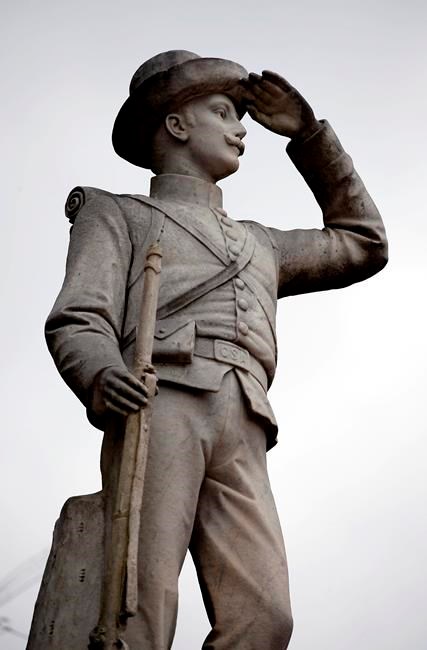JACKSON, Miss. — A Confederate monument that's been a divisive symbol at the University of Mississippi will be moved from a prominent spot on the Oxford campus to a secluded Civil War cemetery.
The state College Board on Thursday approved a plan to move the monument, but did not say when it might happen.
The decision happened amid widespread debate over Confederate symbols as people across the U.S. and in other countries are protesting racism and police violence against African Americans.
The University of Mississippi was founded in 1848, and the marble statue of a saluting Confederate soldier was put up in 1906. It is one of many Confederate monuments erected across the South more than a century ago.
Critics say its display near the university’s main administrative building sends a signal that Ole Miss glorifies the Confederacy and glosses over the South’s history of slavery.
“We shouldn’t run from our past. ... But we shouldn’t glorify it,” Joshua Mannery, the Associated Student Body President, said Thursday.
Mannery attended the College Board meeting with a diverse group of 15 other Ole Miss students who have been pushing officials to move the monument. Mannery, who is African American, said the statute represents white supremacy.
Because of the coronavirus pandemic, board members met by conference call as a few people listened in the room where the board usually meets. The vote happened quickly and with no discussion during the meeting, quietly culminating a debate that has churned for years.
The estimated cost of the move is $1.2 million, which will be paid with private donations, not public money, the board said.
Mannery told his fellow students gathered outside after the vote: “We did it!"
As they celebrated, a woman who had attended the meeting to oppose moving the statute came outside and raised her voice at the students.
“Why do y'all want to change everything about that school? ... Y'all are the ones that don't even have the money," said Lisa Langley of Vicksburg, who later identified herself as being part of a group called Make Ole Miss Great Again.
The students smiled, waved at Langley and left.
The statue was a gathering point in 1962 for people who rioted to oppose court-ordered integration of the university.
Pro-Confederate groups from outside the university rallied at the monument in February 2019, prompting Ole Miss basketball players to kneel during the national anthem, in protest of the rally. Student government leaders voted two weeks later to ask administrators to move the monument to the cemetery, where Confederate soldiers killed at the Battle of Shiloh are buried.
In December, the Mississippi Department of Archives and History board approved architectural and engineering plans for moving the monument. In January, the College Board delayed a vote on the matter, with members saying they wanted more information.
A former University of Mississippi student was arrested May 30 after he spray painted “Spiritual Genocide” and left bloody hand prints on the monument. He was charged with defacing public property, and the monument has already been cleaned.
Mississippi can be slow to change. After court-ordered integration, some officials said schools would move in that direction with all deliberate speed — but the foot-dragging went on for years. Legislators still often kill proposals by ignoring them.
The University of Mississippi has worked for more than 20 years to distance itself from Confederate imagery, often amid resistance from tradition-bound donors and alumni. The nickname for athletic teams remains the Rebels, but the university retired its Colonel Reb mascot in 2003 amid criticism that the bearded old man looked like a plantation owner. In 1997, administrators banned sticks in the football stadium, which largely stopped people from waving Confederate battle flags. The marching band no longer plays “Dixie.”
Because of a student-led effort, the university in 2015 stopped flying the Mississippi flag, the last state flag in the U.S. to prominently feature the Confederate battle emblem.
Since 2016, the university has installed plaques to provide historical context about the Confederate monument and about slaves who built some campus buildings before the Civil War. A plaque installed at the base of the Confederate statue says such monuments were built across the South decades after the Civil War, at a time that aging Confederate veterans were dying.
“These monuments were often used to promote an ideology known as the ‘Lost Cause,’ which claimed that the Confederacy had been established to defend states’ rights and that slavery was not the principal cause of the Civil War,” the plaque says. “... Although the monument was created to
___
Follow Emily Wagster Pettus on Twittter at http://twitter.com/EWagsterPettus.
Emily Wagster Pettus, The Associated Press

